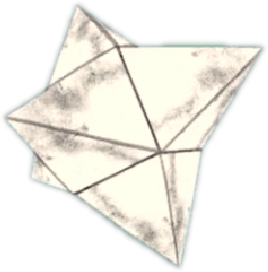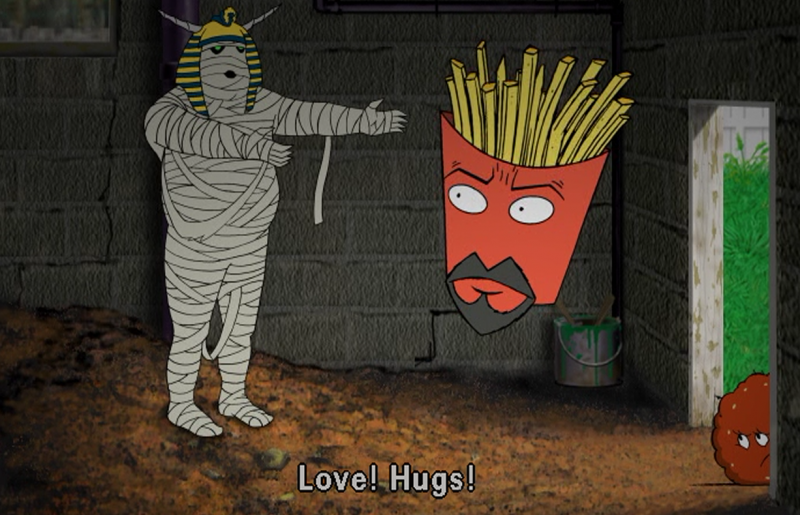Download this article in PDF format
On February 26, 2015, Miriam Katz sat down with Birgit Rathsmann and Mary Houlihan, who voiced the white shape in Rathsmann’s web series, “Primitive Games,” made for Pastelegram’s tenth online issue. The day before, Katz had interviewed Rathsmann and her other two collaborators, Becket Bowes and Lorelei Ramirez (that interview transcript is also in this online issue).
Katz, Houlihan and Rathsmann discussed the collaborations behind the writing and animating of “Primitive Games,” particularly their reliance on improv acting techniques and interest in comedy shows. They also cover its pull away from traditional artistic contexts.

All images are stills from “Primitive Games,” unless otherwise captioned.
Mary Houlihan: So this project was interesting because they’re comedy videos but they’re for an art context or an art publication. Sometimes you want do something that is funny in an art context, you have to bend your words around it—‘Oh actually it’s addressing … ‘—instead of just doing what you wanna do. And who cares?
Birgit Rathsmann: The reality is that we all spend more time talking about TV shows than art shows.
Miriam Katz: I am curious because … was the process, or what you’ve seen from the outcome, would it be different if it had been read only out of the comedy world. It came from four people who all went to art school. Maybe the answer is no, but it seems like it is slightly different than a comedy video or at least the process of making a comedy video.
Mary: We didn’t go into it listing fine artists to reference. I guess what’s different is that when making a comedy video you’re thinking more about the not-fun industry things about like, ‘Who’s our most famous friend that we can get to be in this, so we can get more clicks or who’s your friend who works at Funny or Die, we should get it on there.’ With this project there was no thinking along those lines.
Birgit: There was no thinking along art lines and no thinking along comedy lines, in a way. We didn’t think about either.
Miriam: Because you already have the platform, and it happens to be an art venue.
Birgit: That totally freed us up to do whatever we want.
Mary: It already has a home. We’re not thinking about the best way to get a bunch of people to see it or if we’ll get discovered.
Miriam: Do you think there was less interest in the bottom line of being funny?

Mary: Maybe yes, but perhaps it is more because our focus was trying to hit thought-points only through improvisation. It feels less like you’re trying to get in a joke every two seconds.
Miriam: How does this fit into the context of your stand-up or visual art that you’ve made?
Mary: I think some of this is different. When I make an animation I write everything and don’t really include people. Having it be collaborative was different. I also do plays and sketches that are more comedic so it was similar to that. I think a big part of the fun is even when you’re putting a lot of work into it, the other person has ownership. The fun in the process is coming up with better lines or trying to come up with stuff that makes the other person laugh.
Miriam: Can you say something about the method of improvisation and how that’s useful to you or generative to you?
Mary: When I improvise, I’m interested—even when it’s just me and one other person on stage—I’m interested in really fucked-up relationships between the people. I feel like they always end up screaming at each other or revealing that that they’re in love with each other. For this project it seemed important that the three of us should be having revelations that heighten it or add more depth or more urgency to what they’re doing. I think sometimes in the process that became a problem. Like we would have to take a time-out and figure, ‘That last recording was just bickering and we weren’t hitting any of the plot points and this probably isn’t any fun to watch, this is fun to listen to right now … but when it has visuals on top why would somebody want to watch this?’ In order to get the plot moving we would sometimes pause and let one person have a monologue and have space, and figure that we could jump in later. That was different than improvising on stage but it was helpful for trying to get this storyline.
Miriam: What did this project lead you to want to do in other projects? Or has it led to anything else, like wanting to work more collaboratively, or in different contexts?
Mary: I think so. I like the idea of improvising an audio thing and having to add on to that. I really like Comedy Bang Bang the podcast, and The Best Show—it’s a radio show—both are all audio and a lot of improvising. Audio is way funnier if you’re talking for a long time about something very specific. When you’re making an audio recording, you want to over-describe things. But it’s going to be overkill, if there’s an image to it.
Miriam: You know that you have the animation to add what isn’t being described. The animation is almost editing the improvisation that you can add whatever. The way in which you maybe failed at improvising you could maybe tack on visually.
Birgit: At the beginning, more over-describing happened, and I would just edit it out and put in the image you being referenced. The whole work gets constructed when we come up with the short scenarios, then it gets constructed when we improvise, and then it gets constructed again when I edit it. It’s a three-draft process.
Miriam: That’s interesting because I think a lot about how the art world and the comedy world can come together. People seem to be considering what it is to have the visual element being central, especially when it is a televised thing; for example, Lance Bangs directing stand-up comedy specials. When you perform live there’s something electric about that already, but when you have the same set on TV, then you need something more.
Mary: Did you see the new Chelsea Peretti special?
Miriam: Yeah, Lance Bangs directed that.
 Still from Chelsea Peretti: One of the Greats, dir. Lance Bangs, 2014. Available on Netflix.
Still from Chelsea Peretti: One of the Greats, dir. Lance Bangs, 2014. Available on Netflix.
Mary: That was so funny to watch for me because she films an hour of standup but they also filmed all these weird edited bits. Like these dogs in the seats. When they do a classic stand-up panning of the audience, there’s dogs sitting there. There’s also a scary clown version of herself in the wings of the theater who heckles her.
Miriam: And how the visual is so essential in that special, instead of Louis C.K. in a t-shirt. I don’t have visuals of any part of Louis C.K.; the hour is just a big hour. Whereas Chelsea’s feels more like chapters, it’s segmented by the dogs and different bits.
Mary: And it’s almost like, a thought-runner. You almost wonder if she is going to die at the end, that the clown is going to get her.
Birgit: Yeah, there’s a narrative structure to it that’s unusual for stand-up specials to have.
Miriam, [to Mary]: Is there something else you wanted to add?
Mary: I want to talk about just a few references that I was thinking of while we worked on the videos. It reminded me a lot of Toy Story, of what toys do when people are gone. Jim Henson made a movie similar to Toy Story. It’s called The Christmas Toy and freaky puppet toys come to life in it. And Adult Swim or Ren & Stimpy, where you’re allowed to be a bit crass and gross. It’s also making me think a lot of Aqua Teen Hunger Force because their technique is improvised nonsense. I don’t think that they even have a storyline, they just record the people doing monologues and then cut out the funniest lines and then animate to it. That’s why it’s so surreal and weird.
 Still from Aqua Teen Hunger Force, 2001 to now. Created by Dave Willis and Matt Maiellaro for Adult Swim on Comedy Central.
Still from Aqua Teen Hunger Force, 2001 to now. Created by Dave Willis and Matt Maiellaro for Adult Swim on Comedy Central.
Miriam: I really like that idea of improvisation. You don’t even have to think about it but afterwards an editor-magician will make it into something else. That seems freeing to not have that obligation—any obligation—to be entertaining or good or smart. Something will come out of it.
Birgit: I’m sure you could script it and you would get actors who would do this. One thing I worried about doing it this way is that the performance never feel rehearsed, never feel dull. You could cut out any moment, and it’ll feel alive. When your characters don’t have a face, don’t have legs or arms, they have to have some life. That’s why improv worked really well, I think, because every sentence was alive because it was a response to something somebody said.
Miriam Katz is a New York- and Los Angeles-based curator and writer. She has organized exhibitions and performances for MoMA PS1, The Kitchen, Art21, Columbia University, and The Artist’s Institute in New York, the Museum of Contemporary Art in Los Angeles, and Silencio in Paris. Her curatorial work has been written about in publications such as Le Monde, The New Yorker, The Village Voice, Bomb Magazine, and The LA Weekly. Katz has guest-lectured at Bard College, Columbia University, the School of Visual Arts, and the Centre Pompidou. She writes about art and comedy for Artforum and Bookforum magazines.
Birgit Rathsmann’s long-term investment in collaborative art practice includes group shows at Helper Projects and at Gasser/Grunert Gallery (NYC). She organized presentations at the East River Band Shell, 163 Eldridge and Alterna Y Corriente (Mexico City). She has shown at the Palais de Tokyo (Paris), Haus der Kulturen (Berlin), Smack Mellon, Pierogi (Leipzig). She has received grants from the Lower Manhattan Cultural Council (Swing Space), New York State Council on the Arts, MacDowell Colony, and the Skowhegan School for Painting and Sculpture. Her MFA in Fine Arts was granted by Hunter College.
Mary Houlihan is a stand-up comedian, writer, actress, animator, and visual artist living in Brooklyn, NY. She is a writer, actor and co-creator of MEAT videos with Keaton Monger and Sam Taggart. She is the co-creator of “Cartoon Monsoon,” a touring theater show consisting of comedic characters and animations. She curates and produces “Comedy Cassette Tape,” an art object/cassette tape with Mike Nigro of the Oxtail Recordings label. She received a BFA in Painting from San Francisco Art Institute in 2011, and has shown at the Diego Rivera Gallery (SF), Root Division (SF), Family Business (NYC), Babycastles (NYC), Dacia Gallery (NYC) and currently has a mural on display at The Silent Barn (NYC). She hosts and produces CUBE Comedy Variety Show with Sam Taggart at Muchmore’s in Williamsburg, every third Monday of the month.
